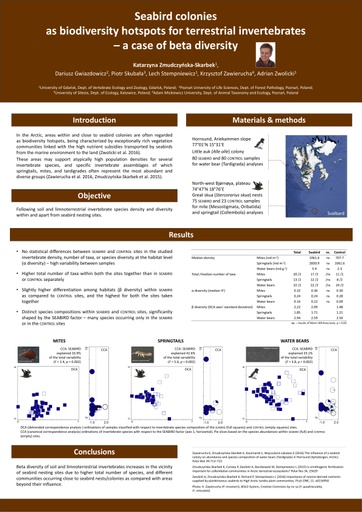pdf Seabird colonies as biodiversity hotspots for terrestrial invertebrates Popular
1988 downloads

Katarzyna Zmudczyńska-Skarbek
Dept. of Vertebrate Ecology and Zoology, Faculty of Biology, University of Gdańsk, Gdańsk, Poland
Gwiazdowicz Dariusz, Dept. of Forest Pathology, Poznań University of Life Sciences, Poznań, Poland
Skubała Piotr, Dept. of Ecology, University of Silesia, Katowice, Poland
Stempniewicz Lech, Dept. of Vertebrate Ecology and Zoology, Faculty of Biology, University of Gdańsk, Gdańsk, Poland
Zawierucha Krzysztof, Dept. of Animal Taxonomy and Ecology, Faculty ofBiology, Adam Mickiewicz University in Poznań, Poznań, Poland
Zwolicki Adrian, Dept. of Vertebrate Ecology and Zoology, Faculty of Biology, University of Gdańsk, Gdańsk, Poland
 In the Arctic, areas within and close to seabird colonies are often regarded as biodiversity hotspots, being characterized by exceptionally rich vegetation communities linked with the high nutrient subsidies transported by seabirds from the marine environment to the land. These areas also support atypically high population densities for several invertebrate species, and specific invertebrate assemblages of which springtails, mites, and tardigrades often represent the most abundant and diverse groups. We present data on abundance and species composition of soil and limnoterrestrial invertebrates from the vicinities of different seabird species nesting sites as compared to impoverished areas, collected from different Svalbard locations: north-west, central, and south-west Spitsbergen, and Bjørnøya. With the use of diversity indices as well as multivariate analytical techniques we quantitatively estimated species diversity at the habitat level (α), the differentiation among habitats (β), and the proportion of total variability in the invertebrate communities explained by seabird influence, and compared these parameters between ornithogenically fertilized and non-fertilized areas. Arctic colonial seabirds are expected to be strongly influenced by predicted climate warming. This may trigger subsequent changes in invertebrate communities, concurrent with those resulting from typical climate change effects, such as increased temperature and reduced moisture availability.
In the Arctic, areas within and close to seabird colonies are often regarded as biodiversity hotspots, being characterized by exceptionally rich vegetation communities linked with the high nutrient subsidies transported by seabirds from the marine environment to the land. These areas also support atypically high population densities for several invertebrate species, and specific invertebrate assemblages of which springtails, mites, and tardigrades often represent the most abundant and diverse groups. We present data on abundance and species composition of soil and limnoterrestrial invertebrates from the vicinities of different seabird species nesting sites as compared to impoverished areas, collected from different Svalbard locations: north-west, central, and south-west Spitsbergen, and Bjørnøya. With the use of diversity indices as well as multivariate analytical techniques we quantitatively estimated species diversity at the habitat level (α), the differentiation among habitats (β), and the proportion of total variability in the invertebrate communities explained by seabird influence, and compared these parameters between ornithogenically fertilized and non-fertilized areas. Arctic colonial seabirds are expected to be strongly influenced by predicted climate warming. This may trigger subsequent changes in invertebrate communities, concurrent with those resulting from typical climate change effects, such as increased temperature and reduced moisture availability.

